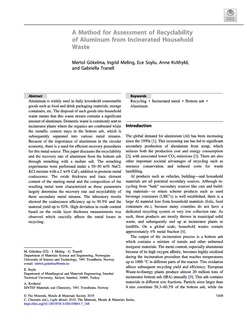| dc.contributor.author | Gökelma, Mertol | |
| dc.contributor.author | Meling, Ingrid | |
| dc.contributor.author | Soylu, Ece | |
| dc.contributor.author | Kvithyld, Anne | |
| dc.contributor.author | Tranell, Gabriella | |
| dc.date.accessioned | 2020-01-23T06:53:51Z | |
| dc.date.available | 2020-01-23T06:53:51Z | |
| dc.date.created | 2019-03-25T11:22:01Z | |
| dc.date.issued | 2019 | |
| dc.identifier.citation | The Minerals, Metals & Materials Series. 2019, 1359-1365. | nb_NO |
| dc.identifier.issn | 2367-1181 | |
| dc.identifier.uri | http://hdl.handle.net/11250/2637534 | |
| dc.description.abstract | Aluminum is widely used in daily household consumable goods such as food and drink packaging materials, storage containers, etc. The disposal of such goods into household waste means that this waste stream contains a significant amount of aluminum. Domestic waste is commonly sent to incinerator plants where the organics are combusted while the metallic content stays in the bottom ash, which is subsequently separated into various metal streams. Because of the importance of aluminium in the circular economy, there is a need for efficient recovery procedures for this metal source. This paper discusses the recyclability and the recovery rate of aluminum from the bottom ash through remelting with a molten salt. The remelting experiments were performed under a 50–50 wt% NaCl:KCl mixture with a 2 wt% CaF2 addition to promote metal coalescence. The oxide thickness and trace element content of the starting metal and the composition of the resulting metal were characterized as these parameters largely determine the recovery rate and recyclability of these secondary metal streams. The laboratory results showed the coalescence efficiency up to 99.5% and the material yield up to 92%. High deviation in oxide content based on the oxide layer thickness measurements was observed which crucially affects the metal losses in recycling. | nb_NO |
| dc.language.iso | eng | nb_NO |
| dc.publisher | Springer | nb_NO |
| dc.title | A Method for Assessment of Recyclability of Aluminum from Incinerated Household Waste | nb_NO |
| dc.type | Journal article | nb_NO |
| dc.type | Peer reviewed | nb_NO |
| dc.description.version | acceptedVersion | nb_NO |
| dc.source.pagenumber | 1359-1365 | nb_NO |
| dc.source.journal | The Minerals, Metals & Materials Series | nb_NO |
| dc.identifier.doi | 10.1007/978-3-030-05864-7_168 | |
| dc.identifier.cristin | 1687465 | |
| dc.relation.project | Norges forskningsråd: 237738 | nb_NO |
| dc.description.localcode | This is a post-peer-review, pre-copyedit version of an article published in The Minerals, Metals & Materials Series 2019. Locked until 16 February 2020 due to copyright restrictions. The final authenticated version is available online at: https://doi.org/10.1007/978-3-030-05864-7_168. | nb_NO |
| cristin.unitcode | 194,66,35,0 | |
| cristin.unitname | Institutt for materialteknologi | |
| cristin.ispublished | true | |
| cristin.fulltext | postprint | |
| cristin.qualitycode | 1 | |
